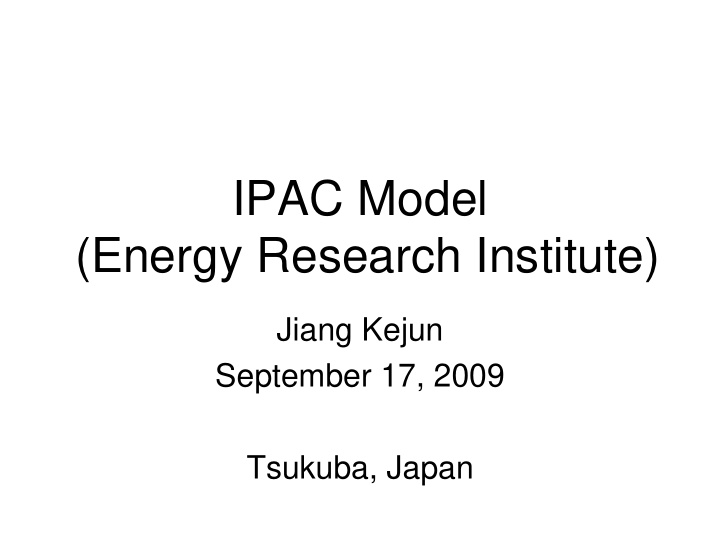



IPAC Model (Energy Research Institute) Jiang Kejun September 17, 2009 Tsukuba, Japan
Framework of Integrated Policy Model for China (IPAC) Environment industry Energy demand and supply Pollutant emission Price/investment Medium/long-term analys IPAC-SGM IPAC-AIM/MATERIAL Economic impact Medium/long-term analysis Energy demand and suppl Energy demand and supply Full range emission Price/investment IPAC-TIMER IPAC-Emission Price, resource, technolog Medium/long-term analysis Medium-long term analysis Economic impact Short term forecast/ IPAC/Tech(Power/Transport) Technology development energy early warning IPAC/SE, IPAC/EAlarm Environment impact Technology policy Medium/short term IPAC/AIM-Local IPAC-AIM/tech analysis Technology IPAC/Gains-Asia assessment Region analysis Detailed technology Medium/short analysis flow Energy demand and supply AIM-air IPAC-health Technology policy Climate Model ERI, China ERI, China
2050 低碳情景模型分析框架 Methodology framework Global energy demand Global Model and supply IPAC-Emission Global GHG Emission China energy and emission Global Target scenarios Burden sharing Energy import/export Energy demand by sectors Energy Price Energy supply Reduction cost Reduction cost Future economic sector detail Energy intensive industry Energy technology model Reduction cost IPAC-AIM/technology Energy economic model IPAC-CGE
Key Design Characteristics • Participating Model: IPAC-Emission • Model Type: Integrated Assessment Model (IAM), using MAGICC as its atmosphere and climate model • Participating Modelers: Jiang Kejun, Liu Qiang, Miao Ren, Hu Xiulian, Zhuang Xing, Wei Xun • Time Step: 5-25 years • Time Frame: 2005-2100 • Solution Type: Dynamic Recursive • Equilibrium Type: Partial Equilibrium • Underlying Computing Framework: Fortune
Inputs and Outputs • Key inputs – Demographics: population by region – Economic: Potential GDP, labor productivity, price and income elasticities. – Resources: Depletable resources by grade (e.g. fossil fuels and uranium); renewable resources by grade (e.g. wind, solar). – Technology: Technology representations of production, transformation and use technologies. • Key outputs – Economic: GDP, World energy and agriculture prices (oil, gas, coal, wheat, rice, etc.) – Energy: Production, transformation, end use, and trade. – Emissions: CO2 emissions by source, non-CO2 emissions (CH4, N2O, etc.), short-lived species emissions (S, BC, CO, NMVOC, etc.).
Regional Scope & Other Detail • Regional Details: – Regional Scope: Global – Number of Sub-Regions: 22 – Asian Regions: China, India, Japan, Southeast Asia, South Asia, other East Asia, Middle East • Other Details: – Energy Demand Sectors: Industry, Transportation, Buildings – Energy Supply Sectors: Fossil Energy Production, Electricity Generation, Hydrogen Production – Other Sectors:
Key Design Characteristics • Participating Model: IPAC-SGM/IPAC-AIM/CGE • Model Type: Regional CGE • Participating Modelers: Jiang Kejun, Liu Qiang, Miao Ren, Hu Xiulian, Zhuang Xing, Wei Xun • Time Step: 5 years • Time Frame: 2005-2050 • Solution Type: Dynamic Recursive • Equilibrium Type: Market Equilibrium • Underlying Computing Framework: Fortune
Inputs and Outputs • Key inputs – Demographics: population – Economic: labor productivity, price and income elasticities. – Resources: Depletable resources by grade (e.g. fossil fuels and uranium); renewable resources by grade (e.g. wind, solar). – Technology: Technology representations of production, transformation and use technologies. • Key outputs – Economic: GDP, energy and products prices (oil, gas, coal, steel, etc.) – Energy: Production, transformation, end use. – Emissions: CO2 emissions by source, non-CO2 emissions (CH4, N2O, etc.)
Regional Scope & Other Detail • Regional Details: – Regional Scope: China – Number of Sub-Regions: – Asian Regions: China • Other Details: – Energy Demand Sectors: 34 sectors – Energy Supply Sectors: Fossil Energy Production, Electricity Generation, Hydrogen Production, biomass – Other Sectors:
Key Design Characteristics • Participating Model: IPAC-AIM/technology • Model Type: technology least cost optimization model • Participating Modelers: Jiang Kejun, Liu Qiang, Miao Ren, Hu Xiulian, Zhuang Xing, Wei Xun • Time Step: 5 years • Time Frame: 2005-2100 • Solution Type: least cost • Equilibrium Type: • Underlying Computing Framework: GAMS
Inputs and Outputs • Key inputs – Demographics: – Economic: output of major industrial sectors, energy price, taxes – Resources: Depletable resources; renewable resources. – Technology: detailed technology representations of production, transformation and use technologies, with cost, energy use, row material use, water use, labour, emission factor, for end use, conversion, and emission control technologies. • Key outputs – Economic: cost – Energy: Production, transformation, end use. – Emissions: CO2 emissions by source, non-CO2 emissions (CH4, N2O, etc.)
Regional Scope & Other Detail • Regional Details: – Regional Scope: China – Number of Sub-Regions: 31 provincials + Hong Kong – Asian Regions: China • Other Details: – Energy Demand Sectors: 38 sectors – Energy Supply Sectors: Fossil Energy Production, Electricity Generation, Hydrogen Production, biomass, Coke making, heat – Other Sectors:
Asian Baselines CO2 Emission by Asian Regions 4,000,000 3,500,000 Japan 3,000,000 Korea 2,500,000 1000t ‐ C China 2,000,000 India 1,500,000 Indonisia 1,000,000 500,000 Middle East 0 Other Asia 1990 2000 2010 2020 2030 2040 2050 2060 2070 2080 2090 2100
Asian Baselines CO2 Emission in China 4000 3500 3000 2500 Baseline Mt ‐ C 2000 Policy 1500 ELC 1000 500 0 2000 2005 2010 2020 2030 2040 2050
Previous Work on Asia - SRES - EMF 21 - China 2050 Energy and Emission Scenarios(2003) - China Low Carbon Society / Future(2006-2009) - China Energy Scenario 2030 - Provincial energy and emission scenarios - Energy Planning and Strategy for China - City and province energy and emission scenarios
Recommend
More recommend